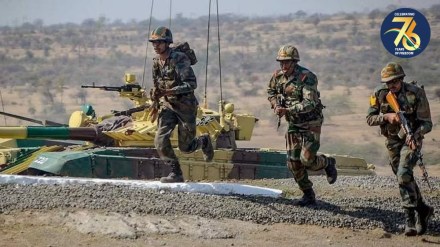In recent times, India’s security landscape has witnessed rapid changes, demanding swift responses to address critical operational requirements. To meet these urgent needs, the government introduced the Emergency Procurement (EP) mechanism, a strategic move that accelerates the acquisition of essential equipment and technology for the defense forces. This article explores the efficiency and significance of the EP mechanism in strengthening India’s military capabilities.
Efficiency of EP Mechanism:
According to sources in defence establishment the EP mechanism has played a crucial role in capital procurement through approximately 140 schemes divided into four tranches (EP I to IV).
The initial three tranches saw the Indian Army allocate nearly Rs 6500 crore for 68 contracts:
– Over Rs 1800 crore was allocated for modern weapons, equipment, and ammunition.
– A similar amount was used for communication and non-communication equipment.
– Approximately Rs 900 crore was dedicated to 10 contracts for surveillance equipment.
– Close to Rs 1500 crore was channeled into 14 projects related to drones and counter-drone systems.
– Nearly Rs 1000 crore contributed to enhancing mobility in various terrains and engineering equipment.
EP-IV, which spanned from September 2022 to September 2023, facilitated more than 70 schemes worth nearly Rs 11,000 crores, breaking down as follows:
– About Rs 1300 crores were spent on weapon systems through 6-7 schemes.
– Rs 1300 crore was utilized across 7-8 projects for protective equipment.
– 9 to 10 schemes received almost Rs 1500 crore for intelligence, reconnaissance, and surveillance.
– Rs 2000 crore was reserved for approximately 10 projects focused on drones and counter-drones.
– Communication and non-communication equipment comprised around a dozen-plus projects, absorbing approximately Rs 1800 crore.
– Lastly, a significant amount of Rs 3100 crore was used for about 25 projects related to survivability and training.
Addressing Key Areas:
“The primary objective of the EP mechanism was to fill critical operational gaps, especially along the Northern Borders,” sources quoted above explained.
Major upgrades facilitated through EP included remote control weapon systems, air defense missiles, anti-tank missiles, satellite downlink and recording systems, VSAT terminals, portable mobile terminals, secure Army mobile systems, all-terrain vehicles, high-mobility reconnaissance vehicles, radars, loiter ammunition, drones, counter-drone systems, high-endurance UAVs, ballistic helmets, navigation systems, and simulation systems.
Promotion of Indigenous Industries:
One noteworthy aspect of the EP mechanism is its emphasis on ‘Atmanirbharta’ or self-reliance. Adding, “In the first three tranches, a remarkable 50% of contracts were awarded to domestic industries. EP-IV concluded more than 70 schemes, amounting to close to Rs 11,000 Crore, all contracted with Indian vendors.”
Economic Prudence:
The EP mechanism isn’t just about expediting procurements; it also exhibits economic intelligence. The first three tranches of EP resulted in savings of approximately Rs 550 Crore. The fourth phase alone saved around Rs 1500 crore.
The Way Forward:
While the EP initiative has played a pivotal role in addressing immediate operational requirements, it is evident that such a mechanism needs to be institutionalized for the long term. The Emergency Procurement mechanism stands as a testament to the government’s commitment to bolstering the nation’s defense capabilities. By addressing operational voids and promoting indigenous industries, EP emerges not merely as a procurement process but as a visionary strategy for a stronger, self-reliant India.
In a world marked by evolving security challenges, India’s commitment to a robust defense framework is essential, and mechanisms like EP exemplify this resolve. Through efficient and strategic procurement, India not only strengthens its defense but also contributes to the growth of its domestic defense industry and economic stability. The future holds promise as India continues its journey toward a self-reliant and secure future.
